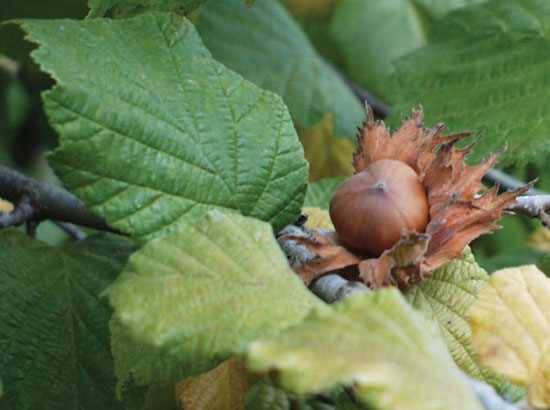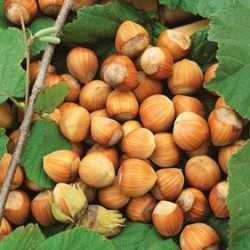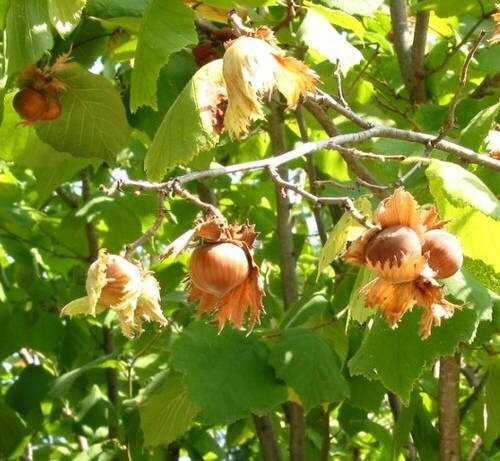- Step 1: Choosing the Right Hazelnut Variety
- Factors to Consider
- Popular Hazelnut Varieties
- Step 2: Selecting the Ideal Growing Location
- 1. Climate Requirements
- 2. Soil Conditions
- 3. Sunlight Exposure
- 4. Wind Protection
- 5. Pollination Requirements
- Step 3: Preparing the Soil for Planting Hazelnuts
- Step 4: Planting Hazelnut Trees
- 1. Choose the Right Location
- 2. Prepare the Soil
- 3. Dig the Planting Hole
- 4. Plant the Tree
- 5. Water the Tree
- 6. Mulch the Base
- 7. Provide Support
- Step 5: Providing Proper Care and Maintenance
- 1. Watering
- 2. Mulching
- 3. Fertilizing
- 4. Pruning
- 5. Pest and Disease Control
- 6. Harvesting
- 7. Winter Protection
- Step 6: Pruning Hazelnut Trees for Optimal Growth
- 1. Timing
- 2. Tools
- 3. Removal of Suckers
- 4. Remove Dead or Diseased Branches
- 5. Thin Out Overcrowded Branches
- 6. Prune for Shape
- 7. Avoid Over-Pruning
- Step 7: Harvesting and Processing Hazelnuts
- 1. Timing the Harvest
- 2. Harvesting Hazelnuts
- 3. Drying the Nuts
- 4. Husking Hazelnuts
- 5. Sorting and Cleaning
- 6. Storing Hazelnuts
- 7. Processing Hazelnuts
- Question-answer:
- What is the best time to plant hazelnut trees?
- How long does it take for hazelnut trees to bear nuts?
- What type of soil do hazelnut trees prefer?
- How often do hazelnut trees need to be watered?
- Are hazelnut trees susceptible to any diseases or pests?
- Video: Growing Hazelnuts
Growing your own hazelnuts can be a rewarding and delicious endeavor. Not only do hazelnuts provide a tasty snack, but they also make a great addition to many recipes. Whether you’re an experienced gardener or just starting out, this complete guide will take you through the steps to successfully grow hazelnuts.
Step 1: Choose the Right Variety
When it comes to growing hazelnuts, it’s important to choose the right variety for your climate and growing conditions. While some varieties thrive in a specific region, others are more adaptable to different climates. Do some research and select a variety that is known to grow well in your area.
Step 2: Preparing the Soil
Before planting hazelnut trees, ensure that the soil is well-drained and has a pH level between 6 and 7. Hazelnuts prefer slightly acidic soil, so make any necessary adjustments to the pH level. It’s also important to clear the area of any weeds or grass and add organic matter to improve the soil’s fertility.
Step 3: Planting Hazelnut Trees
Once the soil is prepared, it’s time to plant the hazelnut trees. Dig a hole that is slightly larger than the root ball of the tree and place the tree in the hole. Ensure that the tree is planted at the same depth as it was in the nursery and fill the hole with soil, gently tamping it down around the tree.
Step 4: Providing Proper Care
Hazelnut trees require regular watering, especially during periods of drought. They also benefit from regular fertilization, particularly in the early years of growth. Prune the trees annually to remove dead or diseased branches and promote healthy growth.
Step 5: Protecting from Pests and Diseases
Just like any other crop, hazelnuts are susceptible to pests and diseases. Regularly inspect your trees for signs of pests such as aphids or squirrels. Additionally, keep an eye out for any signs of disease, such as leaf discoloration or unusual growth. Take prompt action to prevent the spread of pests or diseases.
Step 6: Harvesting Hazelnuts
Harvesting hazelnuts is a rewarding part of the process. Hazelnuts are typically ready for harvesting in late summer or early fall. Shake the branches of the tree to loosen the nuts and collect them from the ground. Allow the nuts to dry for a few weeks before removing the husks.
Step 7: Storing and Enjoying
After harvesting, store hazelnuts in a cool and dry place to preserve their freshness. They can be consumed raw or roasted and make a delicious addition to various dishes, from salads to desserts. Enjoy the fruits of your labor!
“Growing hazelnuts can be a satisfying and fulfilling experience. By following these seven steps, you’ll be well on your way to growing your own delicious and nutritious hazelnuts. So roll up your sleeves, dig in the dirt, and start your hazelnut-growing journey today!”
Step 1: Choosing the Right Hazelnut Variety
When it comes to growing hazelnuts, choosing the right variety is crucial for success. Different hazelnut varieties have specific characteristics and requirements, and selecting the right one will greatly determine the outcome of your hazelnut orchard.
Factors to Consider
- Climate: Hazelnut varieties have varying degrees of cold hardiness, heat tolerance, and adaptability to different climates. Consider your specific climatic conditions and choose a variety that is well-suited to your region.
- Size: Hazelnut trees come in different sizes, ranging from small to large. Consider the available space in your orchard and select a variety that fits your desired tree size and spacing requirements.
- Pollination: Most hazelnut varieties are not self-pollinating, so you will need to plant at least two different varieties that bloom at the same time to ensure cross-pollination and fruit set. Consider the compatibility of varieties for effective pollination.
- Harvest Time: Hazelnut varieties have different maturation times, ranging from early to late-season. Consider your desired harvest time and choose varieties that align with your preferred harvesting schedule.
- Disease Resistance: Some hazelnut varieties are more resistant to common diseases and pests than others. Consider the disease pressures in your area and choose varieties that have good resistance to diseases prevalent in your region.
Popular Hazelnut Varieties
Here are some popular hazelnut varieties that you can consider for your orchard:
| Variety | Characteristic |
|---|---|
| Barcelona | Medium to large size, good flavor, widely adaptable |
| Halls Giant | Large size, excellent flavor, cold hardy |
| Jefferson | Medium size, excellent flavor, disease-resistant |
| Tonda di Giffoni | Small to medium size, sweet flavor, early maturing |
Consult with your local horticulture experts or hazelnut growers in your area to determine the best hazelnut varieties for your specific growing conditions and objectives.
Step 2: Selecting the Ideal Growing Location
Choosing the right location for your hazelnut trees is crucial for their growth and overall success. Here are some factors to consider when selecting the ideal growing location:
1. Climate Requirements
Hazelnut trees thrive in temperate climates with cool winters and mild summers. They prefer areas with moderate rainfall and are sensitive to extreme temperatures. It’s important to choose a location with a climate suitable for hazelnut cultivation.
2. Soil Conditions
Hazelnuts prefer well-drained soil that is rich in organic matter. The ideal soil pH for hazelnuts is between 5.5 and 7.5. Conduct a soil test to determine the pH and make any necessary amendments to improve the soil conditions.
3. Sunlight Exposure
Hazelnut trees require full sun exposure to thrive and produce an abundant harvest. Choose a location that receives at least 6-8 hours of direct sunlight per day. Avoid planting under the shade of other trees or structures.
4. Wind Protection
Hazelnut trees are susceptible to wind damage, especially when they are young. Consider planting in a location with natural windbreaks, such as a wooded area or on the leeward side of a hill. Alternatively, you can create artificial windbreaks using fences or tall shrubs.
5. Pollination Requirements
Hazelnut trees require cross-pollination for optimal fruit set and yield. To ensure successful pollination, plant at least two different hazelnut cultivars within close proximity. Be sure to choose compatible cultivars that bloom at the same time.
By taking these factors into consideration and selecting the ideal growing location, you can set your hazelnut trees up for success and enjoy a bountiful harvest in the future.
Step 3: Preparing the Soil for Planting Hazelnuts
Before planting hazelnut trees, it is important to ensure that the soil is well-prepared to provide the optimal growing conditions. Here is a step-by-step guide to preparing the soil for planting hazelnuts:
- Soil Testing: Start by conducting a soil test to evaluate its pH level, nutrient content, and texture. This will help you determine if any amendments are necessary.
- Clearing the Area: Remove any existing vegetation, rocks, or debris from the planting area. This will create a clean slate for your hazelnut trees to thrive.
- Tilling: Use a tiller or a garden fork to loosen the soil to a depth of 12 to 18 inches. This will promote root penetration and improve water drainage. Remove any weeds or grasses during this process.
- Amending: Based on the results of your soil test, amend the soil as necessary. Adding organic matter, such as well-decomposed compost or aged manure, can improve soil structure and fertility.
- Drainage: Hazelnuts prefer well-drained soil. If your soil has poor drainage, consider incorporating sand or perlite to improve it. You can also create raised beds to ensure proper water drainage.
- Soil pH Adjustment: Hazelnuts prefer a slightly acidic to neutral soil pH range of 5.5 to 7.0. If your soil pH is outside of this range, adjust it by adding lime to raise the pH or sulfur to lower it.
- Final Preparation: Finally, rake the soil surface to create a smooth, level bed for planting. Remove any remaining debris or rocks to eliminate potential obstacles for the hazelnut trees.
By following these steps and taking the time to properly prepare the soil, you can provide an optimal growing environment for your hazelnut trees. This will ensure their healthy establishment and maximize their growth and productivity in the long run.
Step 4: Planting Hazelnut Trees
Planting hazelnut trees is an important step in the process of growing hazelnuts. Here are the steps you need to follow to ensure successful planting:
1. Choose the Right Location

Before planting hazelnut trees, it is crucial to select a suitable location. Hazelnut trees thrive in well-drained soil with a pH level between 5.5 and 7.5. They prefer full sun and require adequate air circulation.
2. Prepare the Soil

Prepare the planting site by removing any weeds or grass. Loosen the soil using a shovel or garden fork, and incorporate organic matter, such as compost or aged manure, to improve soil fertility and drainage.
3. Dig the Planting Hole
Dig a planting hole that is twice as wide and deep as the root ball of the hazelnut tree. This will provide enough space for the roots to spread out. Make sure the hole is deep enough to keep the root collar at ground level or slightly above it.
4. Plant the Tree
Place the hazelnut tree in the planting hole, making sure that the roots are spread out and not bent or crowded. Backfill the hole with soil, firming it gently around the roots to eliminate air pockets.
5. Water the Tree
After planting, water the tree thoroughly to settle the soil and ensure that the roots make good contact with the surrounding soil. Keep the soil moist but not waterlogged during the first year of growth.
6. Mulch the Base
Apply a layer of mulch around the base of the tree, leaving a gap around the trunk to prevent moisture buildup. Mulching helps retain soil moisture, suppress weeds, and moderate soil temperature.
7. Provide Support
If needed, provide support to the hazelnut tree by staking it or using a tree guard to protect against strong winds or animals. Make sure the support is secure but not too tight, allowing the tree to sway naturally.
Following these steps will ensure proper planting of hazelnut trees and give them the best start for healthy growth and abundant nut production.
Step 5: Providing Proper Care and Maintenance
1. Watering
Proper irrigation is crucial for the health and growth of hazelnut trees. Young trees should be watered regularly, especially during hot and dry periods. Aim for deep, thorough watering to encourage deep root growth. As the trees mature, they become more drought-tolerant, but adequate water should still be provided during dry spells.
2. Mulching
Applying a layer of organic mulch around the base of the hazelnut trees can help conserve moisture, suppress weed growth, and improve soil fertility. Apply a 2 to 4-inch layer of mulch, such as wood chips or straw, ensuring that the mulch doesn’t touch the tree trunk to prevent rot.
3. Fertilizing
Hazelnut trees benefit from regular fertilization to ensure optimal growth and nut production. Conduct a soil test to determine the nutrient needs of the trees, and then apply a balanced fertilizer according to the test results. Generally, a slow-release fertilizer with an N-P-K ratio of 10-10-10 or 14-14-14 is suitable for hazelnuts.
4. Pruning
Regular pruning is essential for hazelnut trees to maintain their shape, promote air circulation, and remove dead or diseased branches. Prune during the dormant season before the buds swell to minimize stress on the tree. Remove any suckers or branches that are crossing or rubbing against each other.
5. Pest and Disease Control
Monitor your hazelnut trees regularly for signs of pests and diseases, such as aphids, mites, or Eastern filbert blight. Early detection and intervention can prevent the spread of pests and the development of diseases. Implement cultural practices, such as proper spacing and sanitation, to reduce the risk of pest and disease infestations.
6. Harvesting

Harvest hazelnuts when the husks have turned brown and begin to split open. Fallen nuts can be picked up daily to prevent rotting or infestation. Dry the harvested nuts thoroughly before storing them in a cool, dry place. Hazelnuts can be consumed directly or used in various recipes.
7. Winter Protection
Hazelnut trees can be susceptible to cold temperatures during winter. Protect your trees by wrapping the trunks with burlap or using tree wraps to prevent frost cracks. Apply a layer of mulch around the base of the trees to insulate the roots and protect them from freezing.
By providing proper care and maintenance to your hazelnut trees, you can ensure healthy growth and a bountiful harvest of delicious nuts.
Step 6: Pruning Hazelnut Trees for Optimal Growth
Pruning hazelnut trees is an essential task for ensuring their optimal growth and productivity. Regular pruning helps maintain the tree’s shape, removes dead or diseased branches, and promotes the development of new shoots and healthy fruit production. Here are some key steps to follow when pruning hazelnut trees:
1. Timing
Pruning hazelnut trees is typically done during the tree’s dormant period, which is in late winter or early spring before new growth begins. It’s best to avoid pruning during wet or freezing conditions to prevent diseases or damage to the tree.
2. Tools
Use sharp pruning shears or loppers to make clean cuts. It’s also advisable to have a pruning saw on hand for thicker branches that cannot be easily cut with shears. Make sure to disinfect your tools before and after pruning to prevent the spread of diseases.
3. Removal of Suckers

Remove suckers (vertical shoots growing from the base of the tree) by cutting them off close to the trunk. Suckers can weaken the tree and divert energy from the main branches, affecting overall growth and productivity.
4. Remove Dead or Diseased Branches
Carefully inspect the tree for any dead, damaged, or diseased branches. These should be pruned back to healthy wood, making a clean cut just above a bud or side branch. Removing these branches helps prevent the spread of diseases and promotes the growth of healthy new branches.
5. Thin Out Overcrowded Branches
If the hazelnut tree has branches that are crossing, rubbing against each other, or densely packed, it’s important to thin them out. Choose the weaker or less desirable branches and remove them entirely, leaving room for the remaining branches to grow and develop properly.
6. Prune for Shape
Prune the tree to maintain the desired shape, which is typically a central leader system or an open vase shape. Remove any branches that are growing towards the center of the tree or interfering with the main structure.
7. Avoid Over-Pruning
While pruning is important, it’s crucial not to over-prune hazelnut trees. Over-pruning can cause stress to the tree and reduce its ability to produce a healthy harvest. Aim for a balanced pruning approach that focuses on removing diseased or unproductive branches while preserving the overall structure of the tree.
By following these pruning steps, you can help your hazelnut trees thrive and produce an abundant crop year after year. Remember to always assess the unique needs of your specific tree and consult with experts if needed before conducting major pruning.
Step 7: Harvesting and Processing Hazelnuts
1. Timing the Harvest
In order to ensure the best flavor and quality, it’s important to harvest hazelnuts at the right time. Hazelnuts are ready for harvest when the outer husks begin to turn yellow or brown and start to split. You can also check the maturity of the nuts by cracking a few open and inspecting the kernel.
2. Harvesting Hazelnuts
When harvesting hazelnuts, be gentle to prevent damaging the nuts. Wear gloves to protect your hands and use pruners or shears to cut the hazelnut clusters from the tree branches. Collect the clusters in a bucket or basket, being careful not to drop them or expose them to excessive sunlight.
3. Drying the Nuts
After harvesting, it’s important to dry the hazelnuts to remove excess moisture. Spread the nuts out in a single layer on a clean, dry surface, such as a wire mesh screen or a tray. Place them in a well-ventilated area with low humidity, ideally with a temperature of around 70°F (21°C). Allow the nuts to dry for about two weeks, rotating them occasionally for even drying.
4. Husking Hazelnuts
Once the hazelnuts are dry, the next step is to remove the outer husks. This can be done by hand, by rubbing the nuts between your fingers to loosen the husks. Alternatively, you can use a nutcracker or pliers to gently crack the husks without damaging the kernels underneath.
5. Sorting and Cleaning
After husking, sort through the nuts and remove any damaged or discolored ones. Rinse the hazelnuts under cool water to remove any remaining debris or husk fragments. Make sure to thoroughly dry them afterwards to prevent mold or spoilage.
6. Storing Hazelnuts
Store the processed hazelnuts in an airtight container in a cool, dry place. This will help preserve their freshness and flavor. Avoid storing them in plastic bags or containers, as they can trap moisture and cause the nuts to spoil.
7. Processing Hazelnuts
After harvesting and processing, your hazelnuts are ready to be used in various ways. Hazelnuts can be eaten as a healthy snack, added to baked goods, used in cooking, or processed into hazelnut butter or oil. Get creative and enjoy the delicious flavors of your homegrown hazelnuts!
Question-answer:
What is the best time to plant hazelnut trees?
The best time to plant hazelnut trees is in the late winter or early spring, before the trees start to bud. This allows the trees to establish their root systems before the hot summer months.
How long does it take for hazelnut trees to bear nuts?
It typically takes hazelnut trees 3 to 5 years to start bearing nuts. However, the exact timeline can vary depending on factors such as the variety of the hazelnut tree and the growing conditions.
What type of soil do hazelnut trees prefer?
Hazelnut trees prefer well-drained soil that is rich in organic matter. A soil pH of 6 to 7 is ideal for hazelnut tree growth. If the soil is too acidic or too alkaline, it can affect the health and productivity of the trees.
How often do hazelnut trees need to be watered?
Hazelnut trees require regular watering during the first few years after planting to ensure proper establishment. Once established, they are more drought-tolerant and typically only need supplemental watering during dry periods or prolonged droughts.
Are hazelnut trees susceptible to any diseases or pests?
Yes, hazelnut trees can be susceptible to diseases and pests such as Eastern Filbert Blight, aphids, and mites. It’s important to monitor the trees regularly for any signs of disease or pest infestation and take appropriate measures, such as pruning affected branches or applying organic pest control methods.







